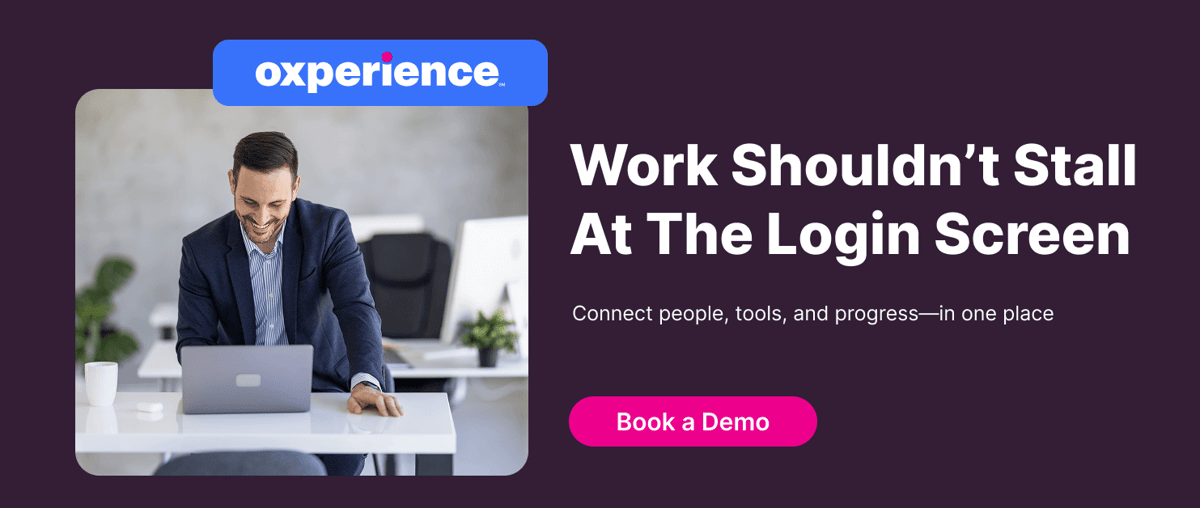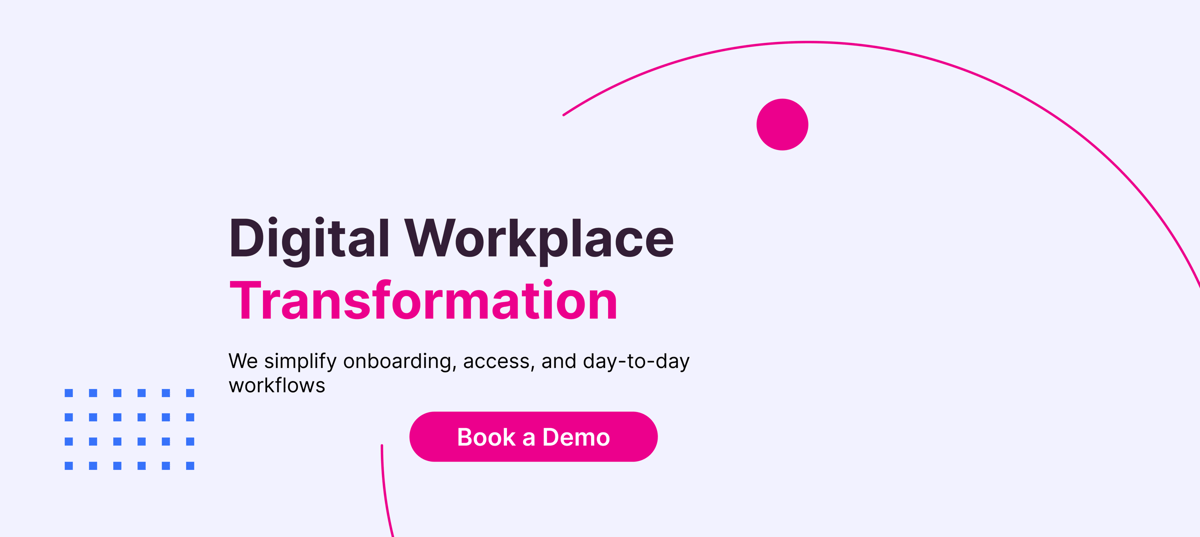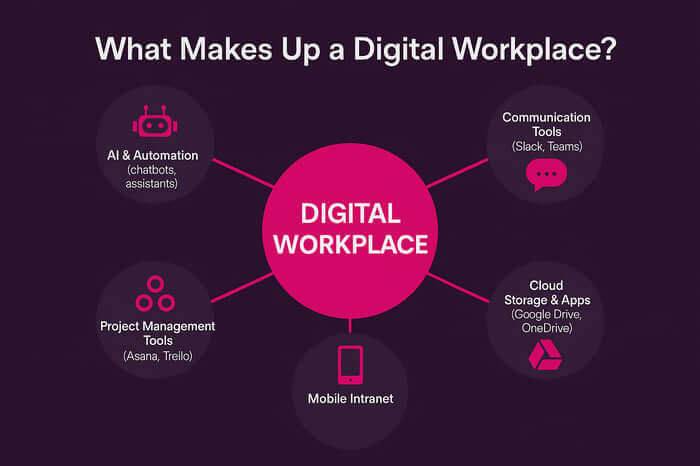Table of Contents
Work doesn’t look the way it used to—and that’s a good thing. Tools have changed. Expectations have shifted.
But somewhere between new platforms and old habits, a lot gets messy.
That’s where digital workplace transformation comes in. Not as a quick fix, but as a smarter way to connect people, processes, and tech.
We’ll break down what digital transformation in the workplace is, why it matters, and how to do it right.
Key Notes
Digital workplace transformation encompasses technology, processes, and cultural shifts beyond just adding tools.
Successful transformation spans four core areas: business model, processes, organization, and technical infrastructure.
Common challenges include digital friction, security risks, and technology fatigue.
What Is Digital Workplace Transformation?
Digital workplace transformation is the shift from traditional office-bound processes to digitally connected, flexible ways of working.
It includes:
Technology infrastructure | Cloud access, secure networks, cross-device usability |
Communication tools | Real-time, integrated collaboration across teams and locations |
Employee experience | Frictionless tools that enable faster, easier workflows |
Processes & automation | Smarter workflows that reduce repetitive tasks |
Data & analytics | Insights that inform better decisions and continuous improvement |
But it’s not just about adding tools. Transformation includes cultural shifts—rethinking how teams work together, encouraging autonomy, and breaking down silos.
Why Digital Workplace Transformation Matters?
Benefits of Workplace Transformation
| For Teams | For Leadership |
|---|---|
| ✅ Gets more done with less friction | ✅ Respond quickly to market changes |
| ✅ Feels confident using their tools | ✅ Make smarter, data-backed decisions |
| ✅ Stays engaged and motivated | ✅ Improve retention and morale |
| ✅ Remains aligned with business goals |
The 4 Core Areas of Digital Transformation
Experts categorize workplace transformation into four key areas:
Business Model
Adapting your revenue models, delivery methods, or value propositions to leverage digital capabilities.
Take Netflix as an example. They started out with DVD rentals and evolved to dominating the streaming space.
Process
Upgrading internal workflows to remove friction. Instead of layering new tech on top of old systems, transformation asks: Is this the best way to work today?
Organization
People matter just as much as tech. This area focuses on structure, leadership, change management, and communication.
Transformation only works when people feel supported and included.
Domain (Technical Infrastructure)
Optimizing the foundational systems: on-prem, cloud, hybrid, or edge. The right infrastructure supports scale, flexibility, and performance.
Benefits of Digital Workplace Transformation
When done right, transformation offers tangible business benefits:
Stronger Collaboration: Teams share ideas faster with fewer barriers
Increased Flexibility: Remote and hybrid options improve satisfaction
Greater Efficiency: Automation frees up time for strategic work
Higher Engagement: Employees feel empowered by tools that work for them
Easy Scalability: New teams, locations, or products onboard smoothly
How to Prepare for Digital Workplace Transformation
Assess Current Tools
Survey your team. What do they love, tolerate, or avoid? Make a tech inventory: what’s outdated, overlapping, or underused?
🔍 Ask:
Where do people waste time?
What tools are non-negotiable?
What workflows are manual or clunky?
Build a Strategic Roadmap
Don’t do everything at once. Start with quick wins, set SMART goals, and phase the rollout.
Example goals:
Reduce onboarding time by 30%
Cut IT support tickets in half
Improve project turnaround by 15%
Train and Support Employees
Great tools fail without great training. Offer multiple formats: video walkthroughs, hands-on sessions, and written how-tos.
Bonus Tip: Appoint "tech champions" to support peers and flag issues early.
Track Progress and Measure Impact
Set metrics before rollout: time saved, error reduction, tool adoption rates, employee satisfaction. Run post-launch surveys and compare with pre-rollout benchmarks.
Handle Resistance Proactively
Not everyone loves change. Create spaces for honest feedback. Explain the "why" clearly and repeatedly. Make support easy to access and judgment-free.
Common Challenges (& How to Handle Them)
Digital Friction
Clunky tools slow people down. Fix it by investing in UX and enabling self-guided help.
Security Risks
Data spread across tools can introduce vulnerabilities. Prioritize access control, audits, and team-wide training.
Tool Overload
Too many apps = context switching chaos. Consolidate where you can and ensure systems integrate.
Tech Fatigue
Change fatigue is real. Avoid burnout by pacing transformation and celebrating wins.
Culture & Connection
It’s hard to maintain culture remotely. Invest in digital rituals, recognition programs, and team-building practices.
FAQs
What’s the difference between digital transformation and IT modernization?
IT modernization focuses on upgrading hardware and software systems. Digital workplace transformation, on the other hand, includes those upgrades but goes further—restructuring workflows, improving employee experience, and aligning technology with company culture and goals.
How do I get executive buy-in for digital workplace changes?
Present transformation as a strategic enabler, not a tech upgrade. Focus on measurable business outcomes, like faster decision-making, reduced costs, and improved employee retention. Highlight competitor benchmarks and ROI projections to build a strong case.
Can digital transformation be done without disrupting daily operations?
Yes. The key is careful planning and phased implementation. Avoid rolling out major changes during peak business periods. Pilot new tools with smaller teams first, gather feedback, and adjust before scaling company-wide.
What happens if employees resist new digital tools?
Resistance is normal and manageable. The best approach is to involve employees early, provide training in multiple formats, and communicate the “why” behind each change. Creating safe feedback loops and appointing peer champions can significantly increase adoption rates.
Conclusion
Digital workplace transformation only works when it makes life easier—for the people doing the work, not just the ones picking the tools.
It’s less about having the latest software and more about making decisions that remove friction, support flexibility, and actually stick.
Done well, it feels like things are finally working with you.
Want faster access, happier users, and a remote access hub that just works—across devices, regions, and platforms? Book a demo with Oxperience and see how it all comes together.






